Page 52 of 386
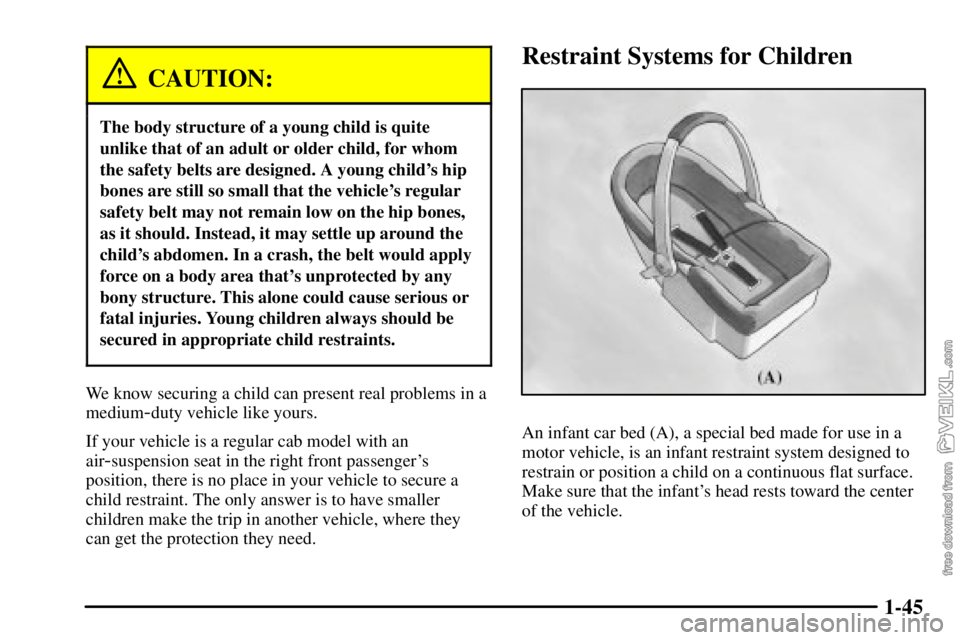
1-45
CAUTION:
The body structure of a young child is quite
unlike that of an adult or older child, for whom
the safety belts are designed. A young child's hip
bones are still so small that the vehicle's regular
safety belt may not remain low on the hip bones,
as it should. Instead, it may settle up around the
child's abdomen. In a crash, the belt would apply
force on a body area that's unprotected by any
bony structure. This alone could cause serious or
fatal injuries. Young children always should be
secured in appropriate child restraints.
We know securing a child can present real problems in a
medium
-duty vehicle like yours.
If your vehicle is a regular cab model with an
air
-suspension seat in the right front passenger's
position, there is no place in your vehicle to secure a
child restraint. The only answer is to have smaller
children make the trip in another vehicle, where they
can get the protection they need.
Restraint Systems for Children
An infant car bed (A), a special bed made for use in a
motor vehicle, is an infant restraint system designed to
restrain or position a child on a continuous flat surface.
Make sure that the infant's head rests toward the center
of the vehicle.
Page 53 of 386
1-46
A rear-facing infant seat (B) provides restraint with the
seating surface against the back of the infant. The
harness system holds the infant in place and, in a crash,
acts to keep the infant positioned in the restraint.A forward-facing child seat (C-E) provides restraint for
the child's body with the harness and also sometimes
with surfaces such as T
-shaped or shelf-like shields.
Page 54 of 386
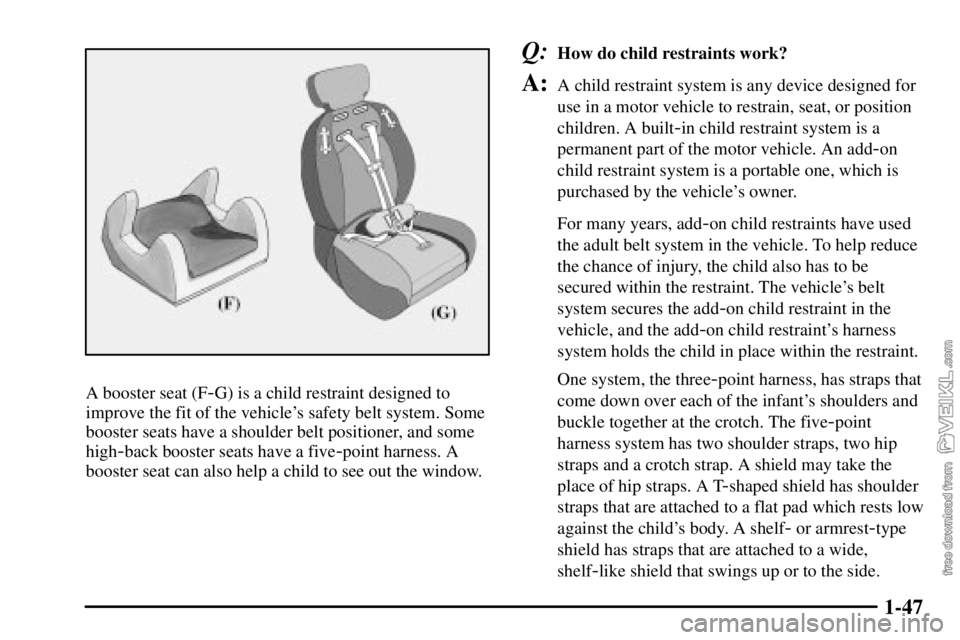
1-47
A booster seat (F-G) is a child restraint designed to
improve the fit of the vehicle's safety belt system. Some
booster seats have a shoulder belt positioner, and some
high
-back booster seats have a five-point harness. A
booster seat can also help a child to see out the window.
Q:How do child restraints work?
A:A child restraint system is any device designed for
use in a motor vehicle to restrain, seat, or position
children. A built
-in child restraint system is a
permanent part of the motor vehicle. An add
-on
child restraint system is a portable one, which is
purchased by the vehicle's owner.
For many years, add
-on child restraints have used
the adult belt system in the vehicle. To help reduce
the chance of injury, the child also has to be
secured within the restraint. The vehicle's belt
system secures the add
-on child restraint in the
vehicle, and the add
-on child restraint's harness
system holds the child in place within the restraint.
One system, the three
-point harness, has straps that
come down over each of the infant's shoulders and
buckle together at the crotch. The five
-point
harness system has two shoulder straps, two hip
straps and a crotch strap. A shield may take the
place of hip straps. A T
-shaped shield has shoulder
straps that are attached to a flat pad which rests low
against the child's body. A shelf
- or armrest-type
shield has straps that are attached to a wide,
shelf
-like shield that swings up or to the side.
Page 55 of 386
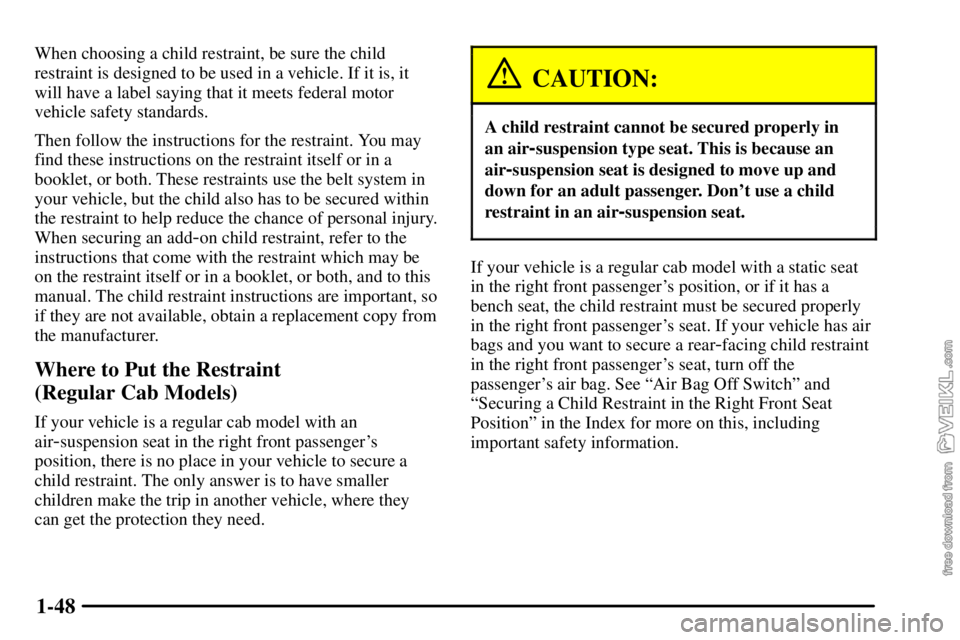
1-48
When choosing a child restraint, be sure the child
restraint is designed to be used in a vehicle. If it is, it
will have a label saying that it meets federal motor
vehicle safety standards.
Then follow the instructions for the restraint. You may
find these instructions on the restraint itself or in a
booklet, or both. These restraints use the belt system in
your vehicle, but the child also has to be secured within
the restraint to help reduce the chance of personal injury.
When securing an add
-on child restraint, refer to the
instructions that come with the restraint which may be
on the restraint itself or in a booklet, or both, and to this
manual. The child restraint instructions are important, so
if they are not available, obtain a replacement copy from
the manufacturer.
Where to Put the Restraint
(Regular Cab Models)
If your vehicle is a regular cab model with an
air
-suspension seat in the right front passenger's
position, there is no place in your vehicle to secure a
child restraint. The only answer is to have smaller
children make the trip in another vehicle, where they
can get the protection they need.
CAUTION:
A child restraint cannot be secured properly in
an air
-suspension type seat. This is because an
air
-suspension seat is designed to move up and
down for an adult passenger. Don't use a child
restraint in an air
-suspension seat.
If your vehicle is a regular cab model with a static seat
in the right front passenger's position, or if it has a
bench seat, the child restraint must be secured properly
in the right front passenger's seat. If your vehicle has air
bags and you want to secure a rear
-facing child restraint
in the right front passenger's seat, turn off the
passenger's air bag. See ªAir Bag Off Switchº and
ªSecuring a Child Restraint in the Right Front Seat
Positionº in the Index for more on this, including
important safety information.
Page 56 of 386
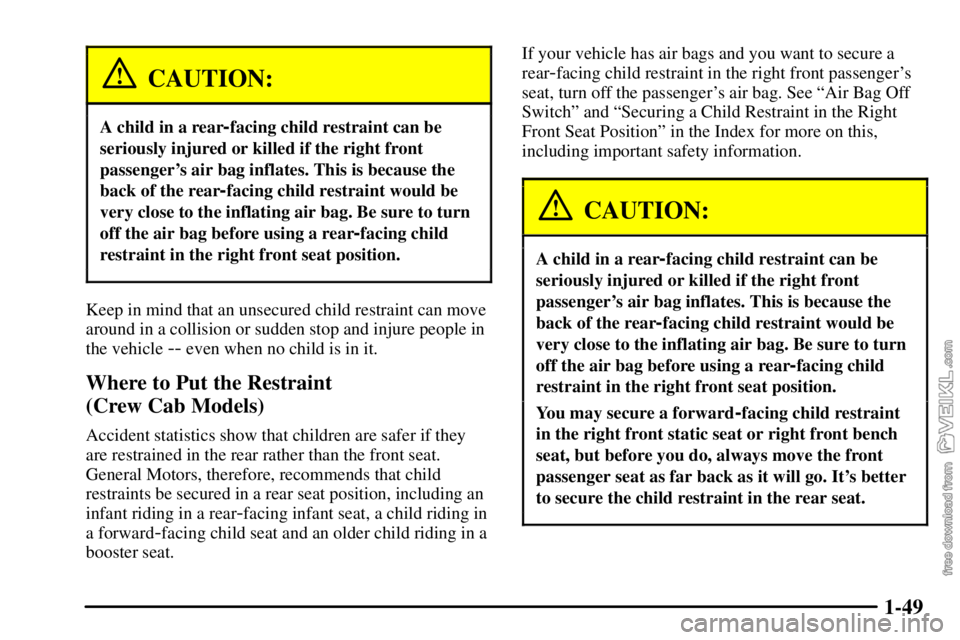
1-49
CAUTION:
A child in a rear-facing child restraint can be
seriously injured or killed if the right front
passenger's air bag inflates. This is because the
back of the rear
-facing child restraint would be
very close to the inflating air bag. Be sure to turn
off the air bag before using a rear
-facing child
restraint in the right front seat position.
Keep in mind that an unsecured child restraint can move
around in a collision or sudden stop and injure people in
the vehicle
-- even when no child is in it.
Where to Put the Restraint
(Crew Cab Models)
Accident statistics show that children are safer if they
are restrained in the rear rather than the front seat.
General Motors, therefore, recommends that child
restraints be secured in a rear seat position, including an
infant riding in a rear
-facing infant seat, a child riding in
a forward
-facing child seat and an older child riding in a
booster seat.If your vehicle has air bags and you want to secure a
rear
-facing child restraint in the right front passenger's
seat, turn off the passenger's air bag. See ªAir Bag Off
Switchº and ªSecuring a Child Restraint in the Right
Front Seat Positionº in the Index for more on this,
including important safety information.
CAUTION:
A child in a rear-facing child restraint can be
seriously injured or killed if the right front
passenger's air bag inflates. This is because the
back of the rear
-facing child restraint would be
very close to the inflating air bag. Be sure to turn
off the air bag before using a rear
-facing child
restraint in the right front seat position.
You may secure a forward-facing child restraint
in the right front static seat or right front bench
seat, but before you do, always move the front
passenger seat as far back as it will go. It's better
to secure the child restraint in the rear seat.
Page 57 of 386
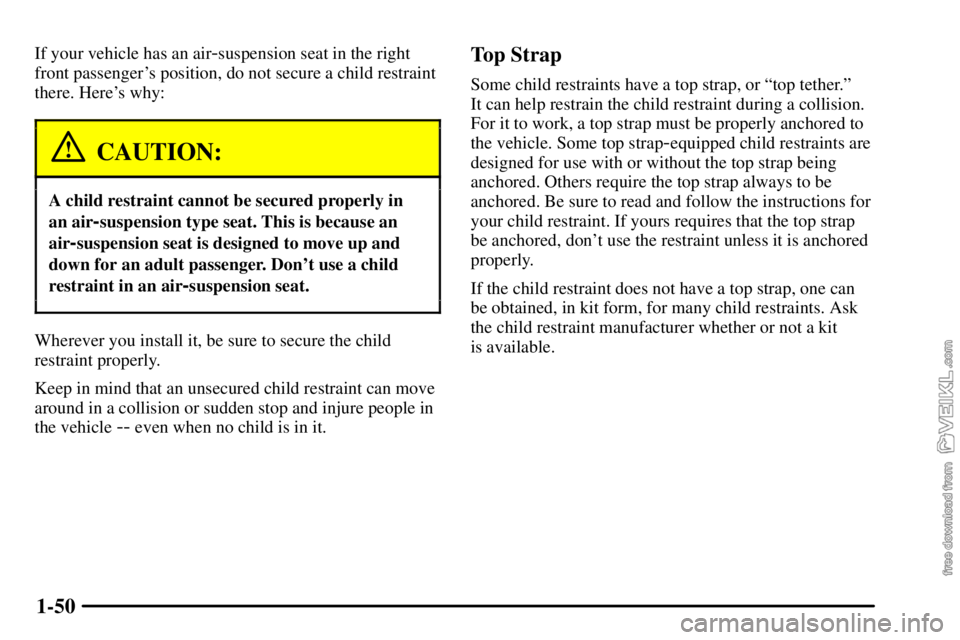
1-50
If your vehicle has an air-suspension seat in the right
front passenger's position, do not secure a child restraint
there. Here's why:
CAUTION:
A child restraint cannot be secured properly in
an air
-suspension type seat. This is because an
air
-suspension seat is designed to move up and
down for an adult passenger. Don't use a child
restraint in an air
-suspension seat.
Wherever you install it, be sure to secure the child
restraint properly.
Keep in mind that an unsecured child restraint can move
around in a collision or sudden stop and injure people in
the vehicle
-- even when no child is in it.
Top Strap
Some child restraints have a top strap, or ªtop tether.º
It can help restrain the child restraint during a collision.
For it to work, a top strap must be properly anchored to
the vehicle. Some top strap
-equipped child restraints are
designed for use with or without the top strap being
anchored. Others require the top strap always to be
anchored. Be sure to read and follow the instructions for
your child restraint. If yours requires that the top strap
be anchored, don't use the restraint unless it is anchored
properly.
If the child restraint does not have a top strap, one can
be obtained, in kit form, for many child restraints. Ask
the child restraint manufacturer whether or not a kit
is available.
Page 58 of 386
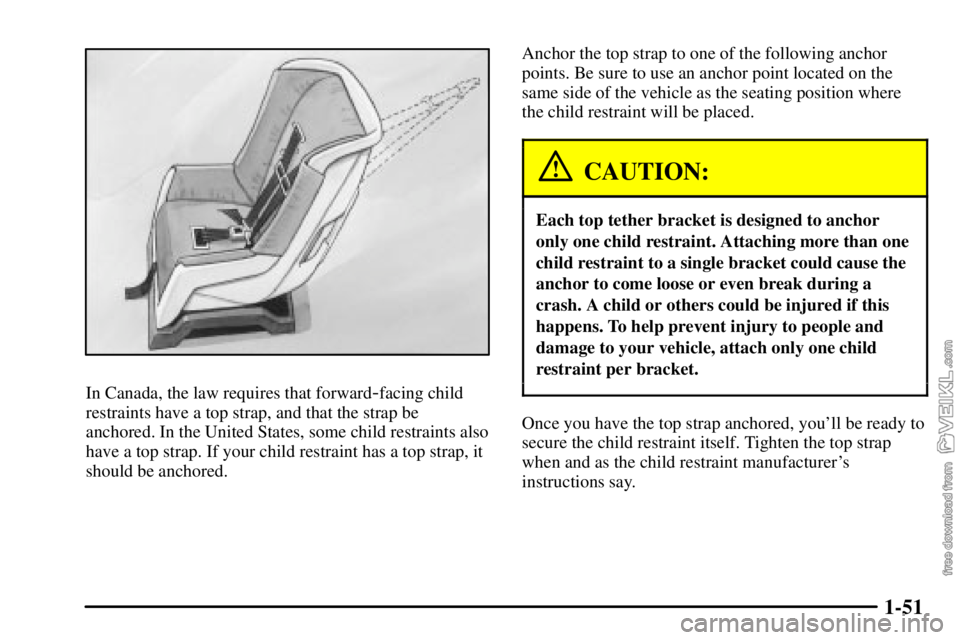
1-51
In Canada, the law requires that forward-facing child
restraints have a top strap, and that the strap be
anchored. In the United States, some child restraints also
have a top strap. If your child restraint has a top strap, it
should be anchored.Anchor the top strap to one of the following anchor
points. Be sure to use an anchor point located on the
same side of the vehicle as the seating position where
the child restraint will be placed.
CAUTION:
Each top tether bracket is designed to anchor
only one child restraint. Attaching more than one
child restraint to a single bracket could cause the
anchor to come loose or even break during a
crash. A child or others could be injured if this
happens. To help prevent injury to people and
damage to your vehicle, attach only one child
restraint per bracket.
Once you have the top strap anchored, you'll be ready to
secure the child restraint itself. Tighten the top strap
when and as the child restraint manufacturer's
instructions say.
Page 59 of 386
1-52
Rear Seat Top Strap Anchors (Crew Cab Models)
CAUTION:
Each top tether bracket is designed to anchor
only one child restraint. Attaching more than one
child restraint to a single bracket could cause the
anchor to come loose or even break during a
crash. A child or others could be injured if this
happens. To help prevent injury to people and
damage to your vehicle, attach only one child
restraint per bracket.
Anchor the top strap to this bracket. For the left
outboard seating position, use anchor point (A). For the
right outboard seating position, use anchor point (B).
For a center seating position, use either anchor
point (A) or (B).